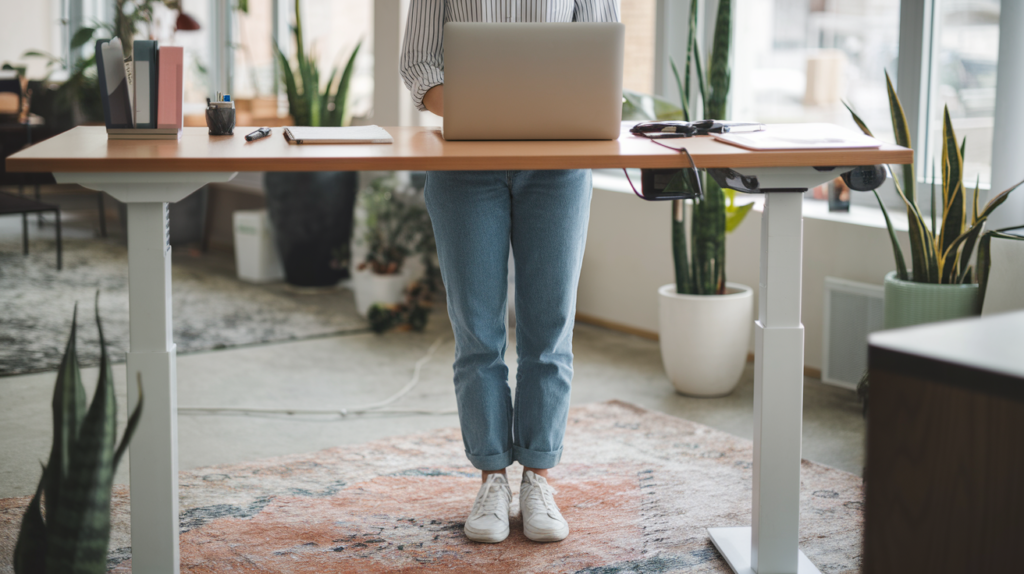Sitting at a desk all day may seem like a comfortable routine, but over time, it can lead to a range of physical discomforts that affect your well-being. Whether it’s persistent back pain, tight hip flexors, neck stiffness, or even regular headaches and migraines, the effects of sitting for long hours can take a toll on your body. In fact, repetitive strain injuries (RSIs) and musculoskeletal issues are common complaints for office workers. But don’t worry — you can avoid or alleviate these problems with the right approach. Here are seven top tips to stay comfortable and healthy in a desk-based role.
1. Move Regularly — Break the Cycle of Sitting
One of the most important things you can do for your body is to move regularly. Sitting for extended periods can cause muscle stiffness and poor circulation, leading to discomfort and pain. Set a timer to remind yourself to stand up and stretch every 30 minutes. Even small movements like walking around your desk or performing some gentle stretches can significantly improve your comfort. This is especially helpful in preventing back pain, tight hips, and neck strain. For an easy guide to office stretches, try this simple stretching routine from Bupa Health.
2. Invest in Ergonomic Equipment
Your office setup plays a significant role in your comfort. Ensure your chair provides adequate lumbar support and adjust the height so that your feet are flat on the ground, and your knees are at a 90-degree angle. Your computer screen should be at eye level to avoid neck strain, and your wrists should remain straight when typing. Ergonomic keyboards and mouse options can also reduce the risk of repetitive strain injuries like carpal tunnel syndrome and tendinitis. If you’re looking for high-quality ergonomic solutions, consider visiting Back in Action, a local Marlow-based business offering a wide range of premium ergonomic products alongside some more modest options like the stylish VLUV ergonomic seating ball
3. Stretch and Strengthen to Combat Tightness
Sitting for long hours can lead to tight hip flexors and a weak core, often causing lower back or hip pain. A simple hip flexor stretch can help maintain flexibility and ease discomfort. Strengthening your core and lower back also reduces strain from prolonged sitting and supports better posture.
4. Stay Hydrated and Take Care of Your Eyes
Dehydration and eye strain are two common issues for office workers. Ensure you drink plenty of water throughout the day to keep your body hydrated and support overall well-being. For eye strain, try the 20-20-20 rule: every 20 minutes, look at something 20 feet away for at least 20 seconds. This helps to give your eyes a break from focusing on the screen and can prevent headaches and migraines.
5. Adjust Your Desk Position for Better Posture
Even with an ergonomic chair, a poor desk setup can still cause discomfort. Ensure your desk height allows your elbows to stay at a 90-degree angle while typing, and position your screen at eye level to prevent slouching or neck strain.
Consider a sit-stand desk like the IKEA Segrare – at just £90, it’s an affordable way to alternate between sitting and standing throughout the day, perfect for a home office! Changing positions can help reduce back and neck pain while keeping your energy levels up.
6. Release the Tension: Mindfulness & Breathing Techniques
You know that feeling when your shoulders creep up to your ears, your jaw tightens, and your whole body feels like it’s bracing for impact? Stress doesn’t just live in your mind—it settles into your muscles too. Taking just a few minutes for deep breathing or mindfulness can help reset both.
Try some deep belly breathing or a quick mindfulness exercise to loosen up and refocus. Not only will it ease the physical tension from hunching over your desk, but it’ll also give your mind a much-needed breather. Need a little help? Try this 4 minute breathing exercise to clear your head and relax. Really pressed for time? This 1 minute reset has you covered.
7. Listen to Your Body — Seek Professional Help When Needed
Despite your best efforts, you may still experience discomfort. If pain or stiffness becomes persistent, it’s important to listen to your body. Seeking help from an osteopath can provide you with tailored advice, specific exercises, and hands-on treatments to address musculoskeletal issues. Osteopaths are skilled at diagnosing and treating conditions like back pain, RSIs, and neck tension, helping you improve posture and alleviate pain. If you’re in the Marlow area and looking for a local osteopath, don’t hesitate to contact us for a consultation.
Conclusion: Prioritise Your Comfort and Health
Taking small steps to incorporate movement, stretch regularly, and optimise your office environment can make a huge difference in how you feel throughout the workday. But if you’re struggling with persistent aches and pains, don’t wait until it gets worse — seeking professional help from an osteopath can help you get back on track. Book an appointment today with a local osteopath in Marlow to get personalised care and advice tailored to your specific needs.
By implementing these tips, you’ll be able to maintain a healthy, comfortable work routine and reduce the impact of sitting for long periods.
If you’re looking for a trusted Osteopath in Marlow, I offer:


Book an appointment today and take the first step toward pain-free life!


